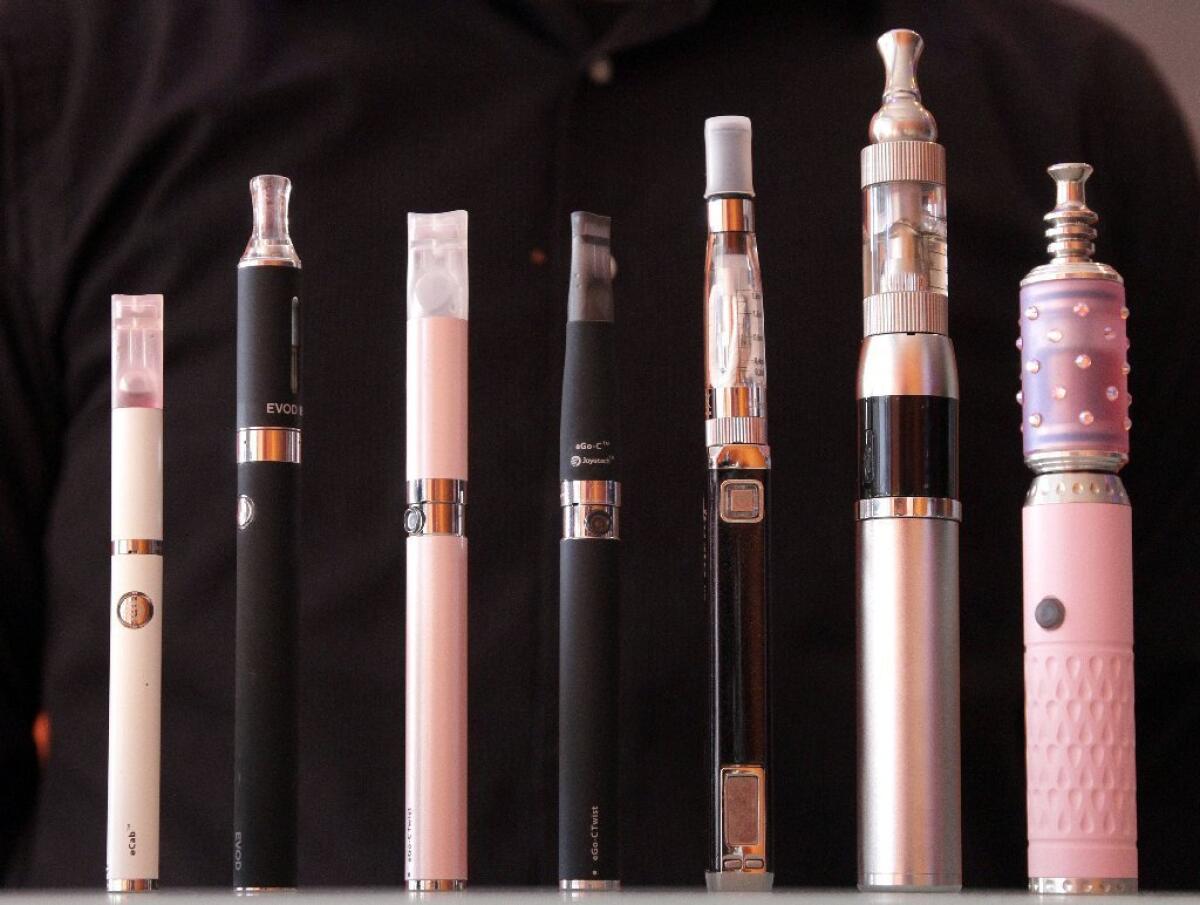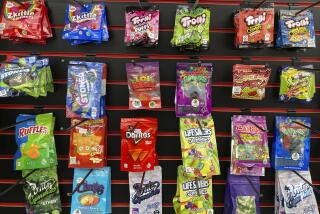Move over tobacco: U.S. teens now prefer e-cigarettes, study finds

- Share via
Electronic cigarettes have surpassed traditional cigarettes as the most popular smoking device among American teens, researchers reported Tuesday.
In fact, 8th and 10th graders were twice as likely to report having used an e-cigarette in the past 30 days as they were to say they had smoked a regular tobacco cigarette, according to the 2014 Monitoring the Future report.
Surveys of 41,551 high school students attending 377 schools around the country revealed that 9% of 8th graders had used an e-cigarette in the past month, compared with 4% who smoked traditional cigarettes. Among 10th graders, 16% reported recent e-cigarette use, compared with 7% who smoked regular cigarettes.
The preference for electronic cigarettes was also apparent among 12th graders — 17% said they used an e-cigarette in the past 30 days and 14% smoked a regular cigarette during that time.
The authors of the annual report, from the University of Michigan’s Institute for Social Research, said this is the first nationwide study to show that e-cigarettes are more popular among teens than regular cigarettes.
“E-cigarettes have made rapid inroads into the lives of American adolescents,” Richard Miech, the report’s senior investigator, said in a statement. “Part of the reason for the popularity of e-cigarettes is the perception among teens that they do not harm health.” (Among 8th graders, for instance, 62% said they thought regular cigarettes were dangerous but only 15% viewed e-cigarettes the same way.)
Although many smokers credit electronic cigarettes with helping them kick their tobacco habit — a belief backed by at least one peer-reviewed research study — public health experts say e-cigarettes are particularly dangerous for teens.
The battery-powered devices heat a liquid nicotine solution into a vapor that is inhaled like cigarette smoke. These vapors come in a variety of kid-friendly flavors like apple pie, bubble gum and cotton candy that deliver enough nicotine to put users at risk of addiction. In January, the U.S. surgeon general’s office warned that exposure to nicotine during adolescence “may have lasting adverse consequences for brain development.”
The e-cigarette users surveyed for the Monitoring the Future report appeared to get most – if not all – of their nicotine through vaping; relatively few said they smoked regular cigarettes as well. Public health experts fear that once they become hooked on nicotine, e-cigarette users will graduate to using regular cigarettes. Some data suggests this may be the case, though experts say more studies are needed to answer this question.
Sen. Barbara Boxer (D-Calif.) said the survey results underscore the need for the Food and Drug Administration to do more to keep e-cigarettes out of the hands of teens.
“This alarming increase in teen use of e-cigarettes demands action, and it is past time for the FDA to finalize strong rules to ban sales to minors and prevent e-cigarette makers from marketing to our kids,” Boxer said in a statement.
The rise of e-cigarettes threatens to undermine recent gains in reducing teen smoking, the University of Michigan researchers said. In 1998, 56% of the students surveyed said they had tried tobacco cigarettes at some point in their lives. By 2014, that figure had dropped to 23% – the lowest level in the 40 years that researchers have been producing the Monitoring the Future report. The prevalence of smoking within the past 30 days was down to 8% this year, compared with 28% in 1998.
The survey measured a variety of teen vices and found that alcohol use also hit a new 40-year low. In 2014, the proportion of students who said they drank at least once in the previous year was 41%; that figure peaked in 1997, at 61%.
Even binge drinking was down this year, with 12% of all students reporting that they had consumed five or more drinks in a row in the two weeks before taking the survey. However, among high school seniors, the binge drinking rate was 19%.
Teens also reported declines in the use of a variety of illicit and dangerous substances, including marijuana (24% among all students), synthetic marijuana (6% among 12th graders), bath salts (less than 1% among students of all grades), ecstasy (2.2% for all students) and salvia (less than 2% among 12th graders), according to the report. Use of especially dangerous drugs like heroin, powder cocaine, crack, methamphetamine, crystal meth, and LSD remained flat in 2014 compared with 2013.
Funding for the Monitoring the Future report came from the National Institute on Drug Abuse, part of the National Institutes of Health.
For more health news, follow me on Twitter @LATkarenkaplan and “like” Los Angeles Times Science & Health on Facebook.







